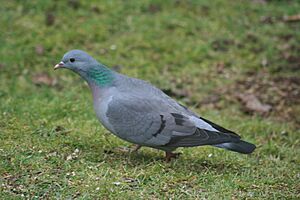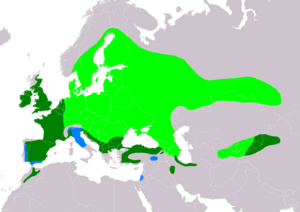Stock dove facts for kids
Quick facts for kids Stock dove |
|
|---|---|
 |
|
| Conservation status | |
| Scientific classification | |
| Genus: |
Columba
|
| Species: |
oenas
|
 |
|
| Range of C. oenas Breeding Resident Non-breeding | |
The stock dove (Columba oenas) is a type of bird in the dove and pigeon family. These birds live across many parts of Europe, Asia, and North Africa. They are known for making their homes in holes found in old trees.
Contents
What's in a Name?
The stock dove got its official scientific name, Columba oenas, in 1758. A famous Swedish scientist named Carl Linnaeus gave it this name. He put it in the group of birds called Columba, which means "pigeon" in Latin. The second part of its name, oenas, comes from an old Greek word for "pigeon."
There are two main types, or subspecies, of stock doves:
- C. o. oenas: Found in western Europe, Northwest Africa, and parts of Asia.
- C. o. yarkandensis: Lives in central and western China.
What Do They Look Like?
Stock doves are part of the Columba group, which includes many pigeons. Most birds in this group are light grey or brown. They often have white marks on their heads or necks. Some even have shiny green or purple patches on their necks and chests.
The stock dove is a bit less grey than other pigeons in Europe. It's important not to confuse them with other common pigeons.
- The common wood pigeon is much bigger. Adults also have white patches on their necks and wings.
- The rock dove looks more like the stock dove in size and color. But wild rock doves usually have a white patch on their lower back. They also have two clear dark stripes on their wings. Stock doves have a grey lower back and less clear wing stripes.
- Feral pigeons (which are the same species as rock doves) can look very different. Sometimes, they might look a lot like stock doves.
Stock doves are friendly birds. They often hang out with wood pigeons, especially when there's food around.
Their call is a short, deep sound that sounds like "Ooo-uu-ooh." It's different from the cooing sound of a wood pigeon. Some people even say it sounds like a "roaring" sound!
Where They Live and How They Live
The stock dove is the least common wild pigeon in Europe. But you can still find many of them in places they like to live. Some stock doves travel long distances, migrating between different areas.
Sadly, their numbers have gone down in some places, like France. However, they are not considered a threatened species in Europe. More than half of all European stock doves live in the United Kingdom.
Nesting and Home
Stock doves usually build their nests in holes inside old trees. Before many forests were cut down, stock doves were very common. They loved nesting in old oak or pine trees. Since they need holes to nest, they are harder to find in newer forests.
A female stock dove can have two sets of babies in one year. This means she needs two different holes for her nests! They have also been seen nesting in other places, like:
- Rabbit burrows (tunnels in the ground)
- Old buildings or ruins
- Cracks in cliffs
- Thick ivy plants
- Around the bottom of lime trees
They will even use nest boxes that people put up for them. The hole for their nest should be about 75 centimeters (about 30 inches) deep. The opening should be big enough for your fist to fit through. They don't use much nesting material. The baby birds, called squabs, often leave the nest hole quite oily. Stock doves like to nest close to each other. When it's not breeding season, they might also rest in these holes.
Habitat and Flight
Stock doves generally prefer open areas, even though they nest in trees. They don't like very dense forests. You can also find them often on coasts, where cliffs provide many holes for nesting.
Their flight is fast and steady. They beat their wings regularly, sometimes giving a quick flick. This is a common way for pigeons to fly. When they land, they perch well. During their mating display, a male stock dove will walk along a branch. He puffs out his neck, lowers his wings, and spreads his tail. When they fly in circles during spring, they make a sharp cracking sound with their wings.
What They Eat
Most of what stock doves eat comes from plants. They really like young shoots and seedlings. They also eat grains, insects, and snails. In some areas, they mostly eat acorns and pine seeds.
Their diet can include many different foods, such as:
- Berries (like bay and hawthorn)
- Figs
- Cereal grains
- Beans and peas
- Small bugs they find while walking on the ground
When they migrate in autumn, stock doves often stop in places with lots of acorns. They also eat shoots and leaves to fill up.
Why Are They Called "Stock Dove"?
The name "stock dove" can be a bit confusing. You might think it means they were kept as "stock" for food, like farm animals. But that's not true!
The word "stock" in their name comes from an old English word, "stocc." This word meant "stump," "post," or "tree trunk." So, "stock dove" really means "a dove that lives in hollow trees." These hollow trees near human homes were often used for firewood, which was called "wood stock." That's how they got their name!
The scientific name Columba comes from a Latin word meaning "pigeon" or "dove." This word itself comes from an old Greek word that meant "a diver." Some people think this is because of how pigeons seem to "dive" or "swim" through the air when they fly.



